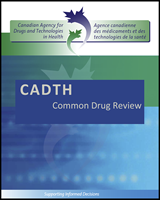Except where otherwise noted, this work is distributed under the terms of a Creative Commons Attribution-NonCommercial-NoDerivatives 4.0 International licence (CC BY-NC-ND), a copy of which is available at http://creativecommons.org/licenses/by-nc-nd/4.0/
NCBI Bookshelf. A service of the National Library of Medicine, National Institutes of Health.
Glycerol Phenylbutyrate (Ravicti) [Internet]. Ottawa (ON): Canadian Agency for Drugs and Technologies in Health; 2017 Apr.
The manufacturer’s submission was modified in the following ways:
- The probability of liver transplantation in patients with early-onset UCD (Subgroup 3 and Subgroup 4) was changed, first, by correcting the calculation of monthly probabilities from underlying rates. It is not possible to correct for issues around mortality and censoring in full; but it is likely that these issues are greater in the probabilities the manufacturer uses for those aged 24 and older versus for those aged 12 years to 24 years. Hence, the probability of transplantation for those aged 24 and older was set to the same probability as used for those aged 12 years to 24 years.
- The probabilities of liver transplantation for patients with late-onset UCD (Subgroup 1 and Subgroup 2) use the manufacturer’s assumption of a relative risk of 0.2 versus those with early-onset UCD. The manufacturer did not probabilistically vary this estimate, but CDR did so on the basis of the uncertainty of the estimate.
- The cost parameters that were assessed as normally distributed are now more appropriately drawn from lognormal distributions.
- The errors in the drawing of lognormal distributions for relative risks of HACs were modified so that the intended distribution is drawn.
- In Subgroup 3, the starting age of the cohort was modified to be two years of age.
- The model was modified to allow the PSA to include 10,000 model runs.
The results of this first reanalysis are provided in Table 4. These results are broadly similar to those provided by the manufacturer. Again, ICURs for GPB versus NaPBA exceeded $5 million, while those for GPB versus dietary control exceeded $1 million per QALY in patients with late-onset UCD, and are between $700,000 and $800,000 per QALY in those with early-onset UCD.
Table 4
CDR First Reanalysis – Results for Patients with Urea Cycle Disorder.
In addition to the preceding varied for the first reanalysis, the full CDR revision of the manufacturer’s model modifies the probabilities of HAC. Following the approach outlined in Appendix IV, the probabilities of HACs were re-estimated using the same data as the manufacturer provided, but using the raw data. The expected HAC rates correspond to 0.27 HAC per year on GPB (versus 0.27 in the manufacturer’s submission), 0.54 HAC per year on NaPBA (versus 0.39), and 1.76 HACs per year on dietary control (versus 2.27). This change is expected to improve the cost-effectiveness of GPB relative to NaPBA but decrease the cost-effectiveness of GPB versus dietary control.
Table 5 provides the revised analysis results. As expected, the incremental cost-effectiveness ratios for GPB are reduced in cases when patients receive NaPBA but increased when the comparison is with dietary control. The ICURs for NaPBA exceed $2 million per QALY, which is 40 times an indicative threshold of $50,000 per QALY.
Table 5
CDR Revised Analysis – Results for Patients with Urea Cycle Disorder (0% Price Discount).
In all cases, it is clear that GPB is not cost-effective at an indicative threshold of $50,000 per QALY. Across the 10,000 model runs underlying the PSA, none of these suggest that GPB is cost-effective (at a willingness-to-pay threshold of $50,000 per QALY) for patients receiving dietary control (i.e., Subgroup 1 and Subgroup 3). For the two subgroups in which patients received NaPBA, the likelihood that GPB is cost-effective (at a willingness-to-pay threshold of $50,000 per QALY) appears to be only 0.02% in patients with late-onset UCD (Subgroup 2) and 0.04% in those with early-onset UCD (Subgroup 4). Based on efficiency grounds, GPB would not be selected in any of the four subgroup analyses presented.
Threshold analyses are provided to identify price discounts at which GPB is likely to become cost-effective at $50,000 and $200,000 per QALY, with a summary of the ICURs produced appearing in Table 6. For the subgroups for which NaPBA is the comparator, a price reduction of around 32% (in late-onset UCD) and 30% (in early-onset UCD) for GPB would be needed for the ICUR to fall to $200,000 per QALY. To obtain an ICUR of $50,000 per QALY, a price reduction of 34% and 32%, respectively, would be required.
Table 6
CDR Revised Analysis – Threshold Analysis for Price Reductions Scenarios.
Higher discounts are required to attain cost-effectiveness in the subgroups for which dietary control alone is the comparator. This is because the cost of the alternative treatment (dietary control) is lower, and because dietary control represents a more cost-effective use of resources than NaPBA. In the case of those on dietary control, a discount of around 59% is necessary to obtain an ICUR of below $50,000 per QALY in patients with late-onset UCD, and 47% in patients with early-onsetUCD. Even at a higher $200,000 per QALY, the discounts necessary are still 53% and 40%, respectively.
- CADTH COMMON DRUG REVIEW REANALYSES - Glycerol Phenylbutyrate (Ravicti)CADTH COMMON DRUG REVIEW REANALYSES - Glycerol Phenylbutyrate (Ravicti)
- INTRODUCTION - Glycerol Phenylbutyrate (Ravicti)INTRODUCTION - Glycerol Phenylbutyrate (Ravicti)
- Glycerol Phenylbutyrate (Ravicti)Glycerol Phenylbutyrate (Ravicti)
- Amivantamab (Rybrevant)Amivantamab (Rybrevant)
Your browsing activity is empty.
Activity recording is turned off.
See more...
